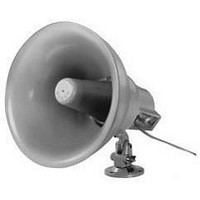AH-5A BOGEN COMMUNICATIONS, AH-5A Datasheet - Page 66

AH-5A
Manufacturer Part Number
AH-5A
Description
Amplified Speaker/horn
Manufacturer
BOGEN COMMUNICATIONS
Datasheet
1.AH-5A.pdf
(88 pages)
Specifications of AH-5A
Peak Reflow Compatible (260 C)
No
Leaded Process Compatible
No
Lead Free Status / RoHS Status
Contains lead / RoHS non-compliant
64
WHY USE 70V OUTPUTS?
Low Currents Allow Long Runs
Why do distributed sound systems use centralized ampli-
fiers with 70V output signals? Because 70V systems can
handle extremely long lengths of wire to connect the
speakers to the amplifier, and they can power a large
number of speakers in each system.
When sending power signals over long distances, it is im-
portant to minimize the amount of current flowing in the
wire. High currents allow too much power, or electrical en-
ergy, to be wasted in wires in the form of heat.
The power (P) lost in the wire is related to the square of the
current (I), so reducing the current in the wires a little
reduces the power lost in them considerably. In fact, reduc-
ing the current flowing in a wire by a factor of 2 will reduce
the power loss by a factor of 4.
However, the power the load demands and the output level
of the amplifier determines the amount of current that must
flow in the speaker wires (Ohm’s law in action).
PAGING SYSTEM TECHNOLOGY
The aim of a paging system is to deliver important audio
announcements, at the proper level and with sufficient
clarity, to people working in a facility and to make those
announcements easily understood. The two most common
ways to accomplish this are to use either 70V central-
ized amplifiers with passive speakers or self-amplified
speakers operating from a 24V DC power supply.
WHAT IS A 70V SYSTEM?
70V Paging Systems
consist of:
• A Centralized Amplifier
as well as easy system expansion.
features to enhance voice and music reproduction
Current Flowing
Power Lost
In Wires
(Watts)
(Amps)
In Wire
P
I
=
=
Current Flowing
Power Needed
By Load
(Watts)
In Wire
(Amps)
I
P
which offers a variety of
2
*
/
Output Voltage
Resistance
Amplifier
(Ohms)
of Wire
(Volts)
R
V
So to lower the amount of power lost in the wires, the
voltage that the amplifier uses to drive the load is
increased. By doing this, the current in the wires can be
reduced while still supplying the same power to the load
(for the same power P, any increase in V will lower I).
Of course you cannot just change the voltage driving a load
from one level to another without also making the load
compatible with the new voltage level. To ensure compati-
bility, 70V systems use transformers on the speakers that
change the high 70V amplifier output levels to lower levels
that are compatible with typical 8-ohm speakers.
Easy To Control Speaker Power Draw
The output of a central paging amplifier is designed to
limit the maximum output voltage that can be supplied to
the speakers. This maximum output voltage remains the
same regardless of the amplifier’s power capacity. Because
the output voltage is limited, speaker manufacturers can
design products that consume a specific amount of power
from the amplifier. This is beneficial in two ways.
First, the speakers will not consume more power than
they are designed for; so, they cannot blow out from using
an amplifier that’s too powerful. Second, since each speaker’s
power consumption is known, the correct amplifier power
for the paging system is simply the total power drawn by all
the speakers.
• Speakers
• An Interface Device
Pages 64-67 explain 70V systems and pages 68-69
explain self-amplified systems. Speaker layout, wiring
methods, and phasing are the same for either technology
and are covered on pages 70-76.
the telephone system. (Depending on the telephone system
and amplifier, an interface device may not be needed.)
Central-Amplified Systems - pages 64-67
because the audio power is supplied from the central-
ized amplifier.
Self-Amplified Systems - pages 68-69
that connect with a simple 2-wire installation
that connects the paging system to












